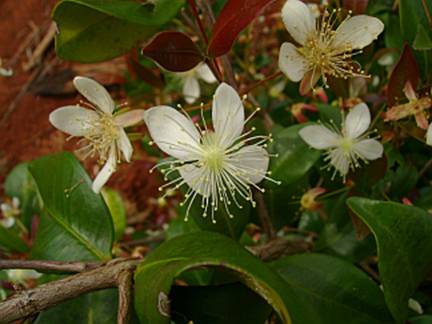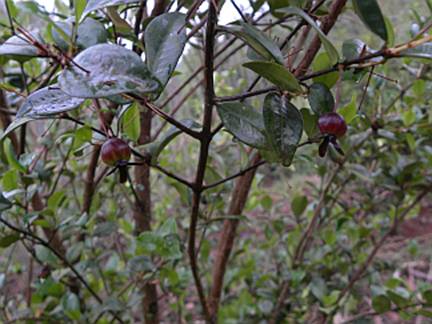EUGENIA SULCATA
FAMILY OF MYRTACEACEAE
|
|
|
|
Flowers |
Fruits |
NATIVE NAMES: PITANGA-UNA – comes from the Tupi-guarani and means “fruit of the thin and black peel". Also the following names are obtained: Pitanguinha preta, Pitanguí and Pitanga preta de jardim.
Origin: Native to the Atlantic Forest, and naturally occurs from the state of Espírito Santo to Santa Catarina, Brazil. More information in Portuguese at the link:
Features: Shrub or tree that grows to medium size 3 to 5 metres high, and forms a thin and rounded crown. The trunk is cylindrical and tortuous, measuring 15 to 55 cm in diameter, with brownish bark that peels in thin and wide plates. The young branches and shoots help in the identification of species, because they are reddish and downy. The young leaves are red, with petiole of 5 mm long and glabrous. The leaf is oval or elongated (longer than wide), glabrous on both sides, diagonally from 2.5 to 5.5 cm long and 1.5 to 2.7 cm wide, base attenuated (flattened) and the pointed tip (long tip). The flowers are in the leaf axils on stalks 1.4 to 3.0 cm long in fascicles (bundles or groups), have pink sepals, the opened flowers have white petals and measure 1 cm in diameter. The fruit is a rounded berry, which is slightly wavy, it has a diameter of 0.8 to 1.2 cm and is black when fully ripe.
Culture Tips: Grows quickly and can be grown anywhere in Brazil, is adapted to temperate, subtropical and tropical climates, tolerates from -3°C to +42°C. They can be planted in full sun or shade, thrives from sea level to altitudes of 1650 m with distributed rainfall throughout the year from 770 to 2500 mm. Prefers a soil which is deep and has a good moisture retention and virtue of the best pH for good yield of fruit should be between 5.5 and 6.7. Can be grown in pots of 40 cm width and 50 cm in height with the same substrate see Propagation. The fruiting begins in the age of 2 to 4 years.
Propagation: The seeds are rounded and whitish, should be exempted from the pulp and then dried for 2 days in the shade, then they are sown in seed boxes (40 x 20 cm and 15 cm height) or bag (7 x 22 cm) to 2 cm of depth. The used substrate should be 50% of well-mixed organic substrate, 20% sand and 30% soil. Germination takes place in 30 to 40 days and is almost completed. The seedlings can be transplanted into individual bags when they are 10 cm high and the substrate must be moist, and should be in full shade and are watered about every day for a month after planting. After about 7 months they are 30 cm tall and can be placed in full sun.
Planting: Plant at a distance of 4 or 5 m between plants, dig planting holes of 50 x 50 x 50 cm. The preparation of the holes made with the filling 30 cm below the surface with 6 shovels of well mixed manure, 500 g of lime and 600 g of wood ash. After the mixture is homogeneous, mix with the soil well and allow 2 months to act. The best time to plant is during the months of September to October. Pour generously once a week in the first 2 months and then only if the moisture is lacking.
Culture: Forming cut of the crown and removing the shoots that grow from the base of the trunk. Fertilize with compost, compost can be 6 kg + 40 g of NPK 10-10-10 be, double the amount each year until the third year, then keep the fertilizing. Irrigation at flowering and fruiting increases productivity and quality of fruit.
Use: Fruiting in the months of September to November. The fruits are consumed in kind and also in the form of juices, jams and ice cream. The flowers produce nectar and pollen, and the tree should be forgotten in bird projects and urban plantings because their fruits and attract many species of birds live.
Back to the seedlist (English) or back to Myrtaceae (Portuguese)

